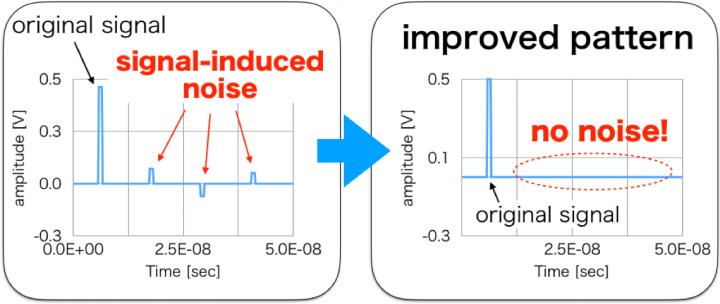Computational algorithm to reduce electromagnetic noise in electronic circuits developed

A pulse signal induces a series of pulses on the transmission line (left). Improvement of the transmission line arrangement and lumped circuit connection provides "noise-free" signal transmission (right). Credit: Osaka University
In order to design noiseless electromagnetic (EM) devices, it is necessary to clarify the mechanism behind EM noise and theoretical calculations and computer simulations are performed for prediction assessment of devices.
Two researchers at Osaka University developed an algorithm for numerical calculation of EM noise (interference) in electric circuits.
EM noise is a problem that has proven to be difficult to solve. Caused by interference from transmission lines and connecting parts, various approaches have been taken to reduce it, such as adding filters and/or passive devices to circuits or using the symmetry of the configuration.
The algorithm developed in this study is for computer simulation of electric circuits in which transmission lines are connected with lumped element models. Usually, the solution of problems along a transmission line is performed using partial differential equations, while the solution of problems in a lumped constant circuit uses ordinary differential equations.
In order to connect these two different differential equations and solve these problems, the pair of researchers, Prof. Masayuki Abe and Prof. Hiroshi Toki, introduced the incidence matrix found in circuit theory and time domain impedance, the latter of which is a new concept.
Previously, this solution required a method to replace lumped constant circuits with transmission lines, but this new method does not require such a replacement, allowing for more practical calculations. The results of this research were published in Scientific Reports.
Based on the results of calculations using this algorithm, the two researchers demonstrated that EM noise could be reduced by using the symmetric 3-line configuration of the circuit. Their calculation method is for one-dimensional multi-conductor transmission lines, but they have already developed a calculation algorithm in two- and three-dimensional multi-conductor transmission lines (patent pending) as well, making it possible to advance its applied research.
This calculation method can also be developed into a calculation method for the retarding effects of EM noise (and signals), which are difficult to calculate via conventional computer simulations. Currently, the researchers are developing a computational algorithm for calculating these retarding effects.
In addition to analysis of time and frequency domains of EM noise, this algorithm will be used for various applications, such as generation of heat by noise, metamaterials, and antenna analysis.
“Eventually, we aim to develop an 'EM noise-less infrastructure.' In addition to improving device performance, we'd like to realize a society in which people can use high value-added equipment, such as equipment with ultra-low power consumption and ultra-low waste heat,” says Prof. Abe. “Specifically, we will theoretically clarify a noiseless structure of electronic circuits and demonstrate that drastic reduction of EM noise can lead to a breakthrough that allows for low power consumption.”
Prof. Toki says, “Our goal is to use our method to develop advanced technology into general purpose technology and establish guidelines for developing the concept of noiseless electronic devices into projects with both social and economic impact.”
###
The article, “Theoretical Study of Lumped Parameter Circuits and Multiconductor Transmission Lines for Time-Domain Analysis of Electromagnetic Noise” was published in Scientific Reports at DOI: https:/
About Osaka University
Osaka University was founded in 1931 as one of the seven imperial universities of Japan and now has expanded to one of Japan's leading comprehensive universities. The University has now embarked on open research revolution from a position as Japan's most innovative university and among the most innovative institutions in the world according to Reuters 2015 Top 100 Innovative Universities and the Nature Index Innovation 2017. The university's ability to innovate from the stage of fundamental research through the creation of useful technology with economic impact stems from its broad disciplinary spectrum.
Website: https:/
Media Contact
All latest news from the category: Information Technology
Here you can find a summary of innovations in the fields of information and data processing and up-to-date developments on IT equipment and hardware.
This area covers topics such as IT services, IT architectures, IT management and telecommunications.
Newest articles

First-of-its-kind study uses remote sensing to monitor plastic debris in rivers and lakes
Remote sensing creates a cost-effective solution to monitoring plastic pollution. A first-of-its-kind study from researchers at the University of Minnesota Twin Cities shows how remote sensing can help monitor and…

Laser-based artificial neuron mimics nerve cell functions at lightning speed
With a processing speed a billion times faster than nature, chip-based laser neuron could help advance AI tasks such as pattern recognition and sequence prediction. Researchers have developed a laser-based…

Optimising the processing of plastic waste
Just one look in the yellow bin reveals a colourful jumble of different types of plastic. However, the purer and more uniform plastic waste is, the easier it is to…



